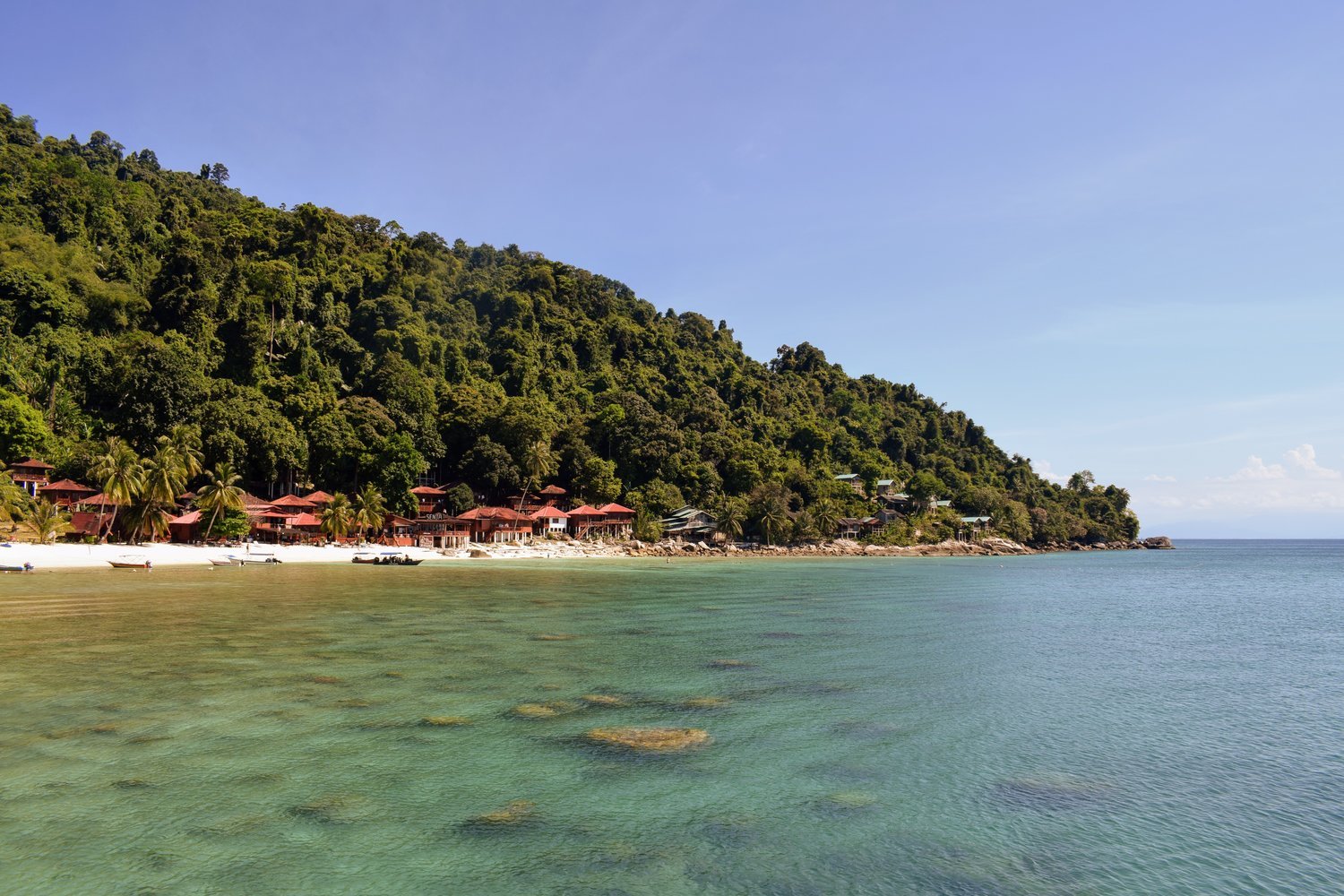Travel
Visiting Lumbini, the Birthplace of the Buddha
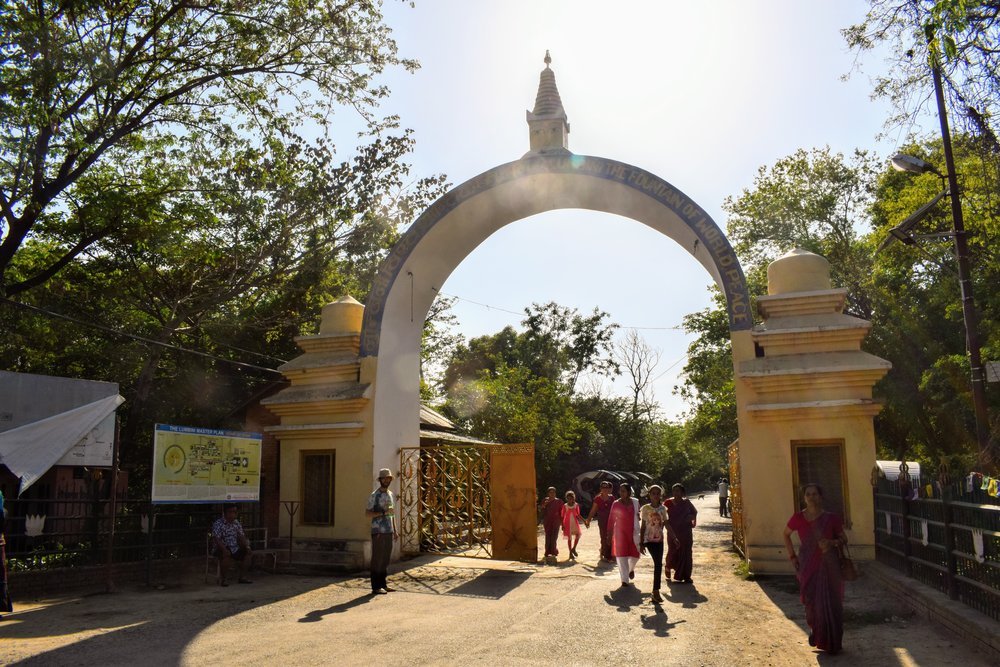
Honestly, the title says it all. On our Nepal trip, Emmett and I managed to spend just one evening in Lumbini, on the border with India. Lumbini’s main draw is the fact that it is the location of the birthplace of the Buddha. Yes, that’s right: the Buddha. The town itself is dusty and somewhat unappealing, but the park around Buddha’s birthplace is a beautiful, walkable testament to the Lord Buddha himself.
How to Get to Lumbini
Within Nepal: Like most domestic destinations in Nepal, the best way to get to Lumbini is by bus. It’s ten hours from Kathmandu, four hours from Chitwan, and about nine from Pokhara.
From India: You can travel via bus or hired car for 14 hours from New Delhi or 7 hours from Lucknow.
What to Expect in Lumbini
The Southbound buses to Lumbini will all have their last stop at the entrance to the park that encompasses the UNESCO World Heritage Site that is Buddha’s birthplace.
A few items to note:
- Entrance into the park is free.
- Entrance to the Maya Devi Temple (ruins of the site where Buddha was born) are 200 rupees per non-SAARC country nationals. (SAARC countries are South Asian countries such as Pakistan, India, Nepal, Bhutan, & Sri Lanka).
- The park is massive! We didn’t have enough time to explore the whole thing. I recommend a half day starting either around 8 AM or at noon. That would be the perfect way to explore Lumbini.
- You don’t have to rent/hire a vehicle, bicycle, or pedicab to see the park. (Unless that’s your preferred method of transportation). If, like us, you prefer to walk, it is easy to do so. Just politely decline any offers.
- There is wildlife that lives within the parks confines! We saw signs warning about the presence of Nilgai (Asian Antelope) within the park.
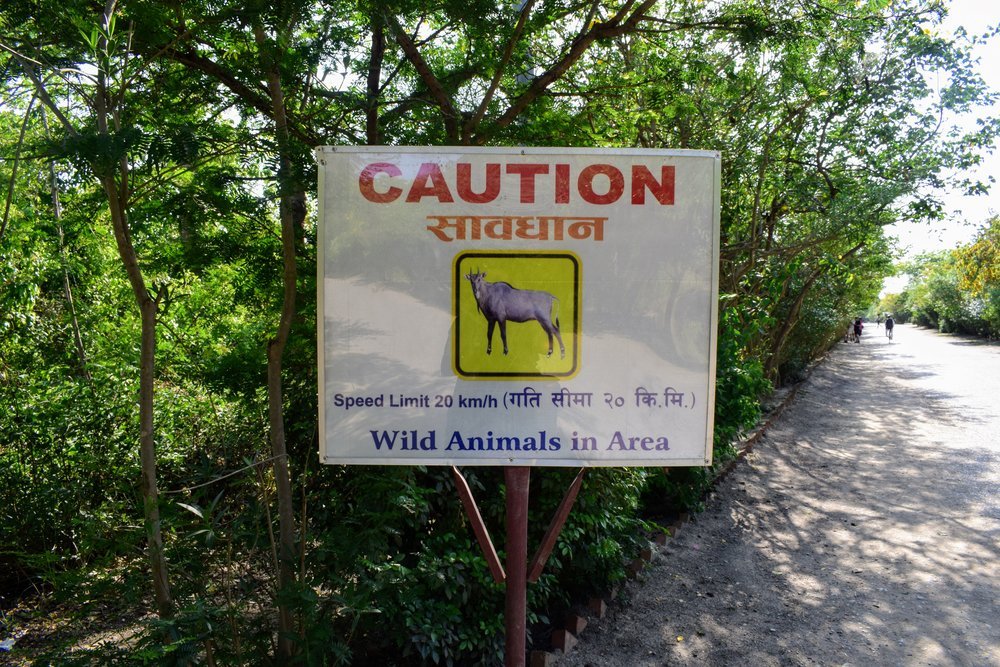
Highlights of Things to Do & See in Lumbini
There’s a ton to be seen and done within the park’s confines, and Emmett & I only barely scratched the surface. Here are some photo highlights from our wander:
Maya Devi Temple
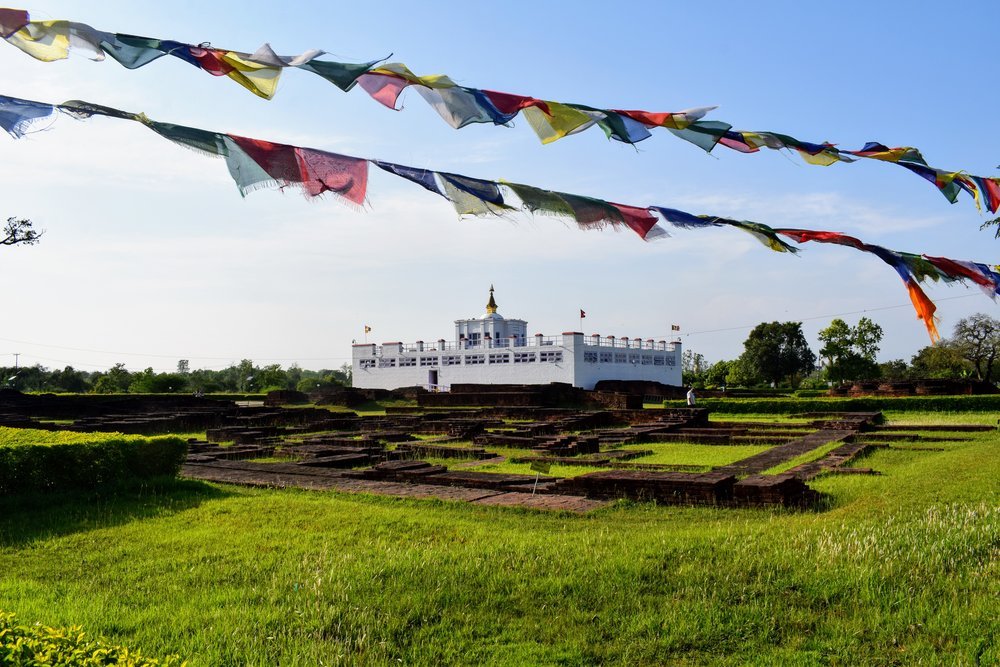
Maya Devi Temple.
Maya Devi is the real main attraction. The temple sits right next to the actual spot where Buddha was born. The large white building houses ruins of an ancient shrine to the Buddha, which you can walk above and view – but be sure to respect the no photos rule inside. The Sacred Garden area outside of Maya Devi Temple is one of the most serene places in the entire park. When we visited, there were many monks gathered beneath the trees and prayer flags, silently reciting mantras.
Standing Baby Buddha Statue
This shiny, happy statue was a gift to Lumbini from Thailand to commemorate Siddhartha’s early years spent in Lumbini.
The Eternal Peace Flame
The Eternal Peace Flame was ignited in November 1986 by a flame brought from the United Nations in New York City. The flames were lit to commemorate 1986 as the International Year of Peace.
The Central Canal
The Central Canal stretches from one end of the park to the other and is 1.4 kilometers (.08 miles) long. There is a small covered motorboat that will take visitors along the canal’s length for a small fee. One end is the Eternal Peace Flame and the other is the World Peace Pagoda.
International Monasteries
Many countries from all over the world have set up monasteries on the grounds of Lumbini. These nations are nearly all Buddhist nations from Asia, with the one exception being the European/German monastery (see above photo).
Beautiful Surrounding Wetlands
Perhaps one of the most surprising things to me about Lumbini was the fact that it is located among some truly beautiful wetlands. We ended up watching the sunset from the park and it was really lovely. As it turns out, Lumbini’s second most famous claim to fame is it’s wetlands-based Crane Sanctuary.
Where to Stay
We stayed in a hotel just off the pretty mediocre bus stop. We were just hoping for a place that didn’t have bedbugs – it didn’t – but it did have a moldy bathroom. In short, I wouldn’t recommend it. That being said, there are quite a few other guesthouses just off the main road. I would recommend that you shop around the guesthouses and hotels. Go into guesthouses to ask to take a look at a few rooms / ask the price / then compare prices before staying anywhere. Either that, or ask your guesthouse or hotel in Pokhara or whichever city you stay in beforehand for recommendations.
You can also stay in one of the monasteries in Lumbini, but you should email them asking about their availability ahead of time. It may be tricky to track their info down online – a possible way around this would be to stay a night or two in a hotel in town and then visit one of the monasteries in person to inquire about accommodation availability. The Korean Monastery does have a Facebook page.
Destinations
6 Destinations Where Earth Feels Like Another World

Some places feel so otherworldly that stepping into them is like walking through a dream. In these destinations, you may even meet single Ukraine ladies or other travelers who share your love for adventure and discovery, and this may add a personal connection to your journey.
The world holds landscapes so surreal that they resemble science fiction settings rather than real places on Earth. Red deserts, glowing caves, and mirror-like salt flats test your senses and spark imagination. These destinations reveal nature’s limitless creativity and the vast opportunities for exploration it offers.
You don’t need a spaceship to see something alien. With curiosity, a will to step beyond the ordinary, and a desire for new perspectives, you can reach places that feel like another world entirely.
#1. Salar de Uyuni, Bolivia
High in the Bolivian Andes lies Salar de Uyuni, the largest salt flat on Earth. During the rainy season, a thin layer of water transforms the vast plain into a perfect mirror and creates the illusion of walking on the clouds. This breathtaking natural phenomenon is so unique that it has been used as a filming location for futuristic movies.
The salt flats stretch for over 4,000 square miles, which makes them feel endless. Visitors often describe the sensation of standing there as both humbling and exhilarating. At sunrise or sunset, the sky melts into the horizon and produces colors so vivid they hardly seem real. The region also features geothermal springs, bubbling geysers, and the hauntingly beautiful Train Graveyard near the town of Uyuni.
For photographers and dreamers alike, Salar de Uyuni offers an unparalleled opportunity to capture surreal reflections and experience the uncanny feeling of being suspended between earth and sky.
#2. Wadi Rum, Jordan
Nicknamed the “Valley of the Moon,” Wadi Rum is a desert landscape so striking that it often stands in for Mars in Hollywood films. Towering sandstone cliffs, deep canyons, and rust-red dunes create an environment unlike anywhere else on Earth.
Wadi Rum has been home to Bedouin tribes for centuries, and exploring it with a local guide provides an unforgettable cultural connection. You can ride a camel across sweeping dunes, hike through narrow gorges, or camp under a sky filled with more stars than you ever imagined possible.
The desert’s silence is profound, broken only by the wind sweeping across the sand. At night, the Milky Way stretches overhead, which adds to the sense of being far removed from the modern world. For those seeking both adventure and tranquility, Wadi Rum offers a landscape that feels truly extraterrestrial.
#3. Cappadocia, Turkey
Cappadocia’s bizarre rock formations, known as “fairy chimneys,” make the region resemble a scene from a fantasy novel. These tall, spindly towers were created by volcanic eruptions and centuries of erosion. Early civilizations carved homes, churches, and entire underground cities into the soft rock and left behind a remarkable blend of natural wonder and human history.
One of the most magical experiences in Cappadocia is to watch hundreds of hot air balloons rise at dawn and float above valleys painted in shades of gold and rose. From above, the landscape looks even more surreal, with winding paths, deep canyons, and ancient ruins scattered across the terrain.
Whether you explore on foot, by balloon, or through the labyrinthine tunnels below ground, Cappadocia delivers a journey into another world — one where nature and human ingenuity intertwine in spectacular ways.
#4. Waitomo Glowworm Caves, New Zealand
Deep beneath the green hills of New Zealand’s North Island lies a hidden galaxy. The Waitomo Caves are home to thousands of glowworms that emit a soft blue-green light, which creates the illusion of a starry night sky underground.
Visitors glide silently through the caves on small boats and gaze up at the glowing formations. The experience is almost spiritual, and it combines natural beauty with a sense of mystery. The glowworms are unique to New Zealand, and this phenomenon is truly one-of-a-kind.
Outside the caves, the surrounding region offers:
- Lush forests
- Dramatic limestone cliffs
- Opportunities for adventure sports, including black-water rafting and zip-lining.
The contrast between the dark, ethereal caves and the vibrant landscapes above ground makes Waitomo an unforgettable destination.
#5. Antelope Canyon, USA
In the heart of Arizona’s desert lies Antelope Canyon, a slot canyon famous for its swirling sandstone walls and beams of sunlight that pierce through narrow openings above. Over thousands of years, flash floods carved smooth shapes into the rock and created a natural sculpture gallery that feels almost unreal.

As you walk through the canyon’s winding passages, the walls shift in color from deep reds to soft purples, depending on the time of day. The light and shadow play creates an ever-changing visual experience.
Antelope Canyon is sacred to the Navajo people, and guided tours provide insights into both the geological wonders and the cultural significance of the site. It is a place where art, history, and natural forces merge and leave visitors awestruck.
#6. Pamukkale, Turkey
Pamukkale, which means “cotton castle” in Turkish, is a natural wonder that looks like something out of a dream. White terraces cascade down a hillside, formed by mineral-rich thermal waters. The bright, snowy appearance of the terraces contrasts sharply with the surrounding green hills and blue sky.
Visitors can walk barefoot across the warm, flowing pools, which are believed to have healing properties. Nearby, the ancient city of Hierapolis adds a fascinating historical dimension, with well-preserved ruins and a theater overlooking the travertine terraces.
Pamukkale offers a rare combination of natural beauty and cultural heritage, and it feels both alien and deeply connected to human history.
In Summary: A Planet of Infinite Landscapes
You don’t need to leave Earth to experience landscapes that seem impossible. From glowing caves and mirror-like salt flats to deserts that could double as Martian terrain, these destinations remind you of the planet’s incredible diversity.
Traveling to such places offers more than stunning photos; it provides perspective. It allows you to see how small yet deeply connected you are to the vast, complex world around you. Whether you seek solitude, adventure, or cultural exchange, visiting locations that feel like another planet will ignite your imagination and leave you forever changed.
Guides
Travel Light, Live Clean: The Nicotine Solution You Can Take Anywhere

Travel has become a defining part of the modern lifestyle. From quick city breaks and business trips to long-haul adventures, we’re a generation that values movement, flexibility, and freedom. But travel often shines a spotlight on our habits—some that enhance the experience, others that can make it more complicated.
For those who use nicotine, smoking or vaping can feel like unnecessary baggage. Strict airport regulations, limited smoking areas, and the constant worry about odour or health risks often weigh down the journey. That’s why tobacco free nicotine pouches are changing the game. They’re discreet, easy to carry, and provide the same satisfaction without the drawbacks of traditional tobacco products.
This article will take you through why nicotine pouches are a smart choice for travelers, how to choose the best nicotine pouches , where to buy nicotine pouches online , and why they’re becoming known as some of the healthiest nicotine pouches available today.
The Travel Lifestyle: Why Convenience Matters
When you’re packing for a trip, every gram counts. Minimalist travelers know the joy of traveling light: fewer things to carry, less stress, and more focus on the experience itself. Nicotine users, however, often face an extra challenge:
- Cigarettes require lighters, ashtrays, and access to designated smoking areas.
- Vapes demand chargers, liquids, spare pods, and the anxiety of airline restrictions.
By comparison, nicotine pouches fit perfectly into the travel lifestyle. They come in small, pocket-sized cans, require no accessories, and can be used anytime, anywhere. Whether you’re sitting on a train in Europe, waiting at an airport gate, or hiking in the mountains, they provide a cleaner, simpler solution.
It’s this freedom that appeals to modern travelers who want practicality without compromise.
What Makes Tobacco Free Nicotine Pouches Different
Traditional nicotine options are tied to tobacco — but nicotine pouches break away from that link. Here’s what makes them different:
- Tobacco-free composition: Unlike snus or cigarettes, these pouches don’t contain tobacco leaves. They’re made with plant-based fibers, food-grade flavors, and nicotine (either natural or synthetic).
- Smoke-free: No combustion, no second-hand smoke, no lingering odour. Perfect for shared environments like airplanes, hotels, or taxis.
- Spit-free: Unlike chewing tobacco, they don’t require spitting, making them discreet and socially acceptable.
- Cleaner experience: Because they’re tobacco free, they don’t stain your teeth or fingers, and they feel aligned with a “live clean” philosophy.
For travelers, these benefits mean restrictions and less hassle — and that adds up to a more seamless journey.
Healthiest Nicotine Pouches: A Step Towards Better Choices
Nicotine itself is addictive, but how you consume it makes all the difference. Compared to smoking or vaping, nicotine pouches are widely seen as a healthier alternative because they remove the toxins associated with burning tobacco or inhaling vapour.
- No tar: Cigarettes release tar that damages the lungs.
- No smoke: Second-hand smoke harms both users and those around them.
- No aerosols: Vaping creates aerosols that may irritate lungs.
While no nicotine product is completely risk-free, opting for the healthiest nicotine pouches allows users to reduce harm while still enjoying the effects of nicotine. For people who are mindful about wellness and travel fitness, this cleaner form aligns with a healthier lifestyle.
The Best Nicotine Pouches for Travel
Not all pouches are created equal. The best nicotine pouches for travelers often share a few qualities:
- Compact and lightweight cans – easy to fit into a pocket, bag, or carry-on.
- Variety of strengths – from mild to strong, so you can control your intake.
- Flavor options — refreshing tastes like mint, citrus, or berry make them enjoyable on long journeys.
- Long-lasting release – perfect for long flights or drives where you don’t want to re-dose frequently.
Some brands specialize in strong, energizing pouches for experienced users, while others focus on smooth flavors and balance, ideal for newcomers. Reading reviews before purchase helps ensure you find what fits your routine.
Buying Nicotine Pouches Online: A Traveler’s Best Friend
One of the best advantages today is the ability to buy nicotine pouches online before your trip. Instead of hunting for products in unfamiliar cities, you can order your favorite brand ahead of time. Online shops often provide:
- Wide selection: More flavors and strengths than typical local stores.
- Competitive pricing: Bulk discounts or subscription options.
- Convenience: Delivered straight to your door.
- International shipping: Many sellers ship across Europe and beyond, ensuring you’re stocked up for global travel.
This ease of access means you can plan ahead and ensure you have what you need – without the stress of last-minute searching.
Practical Scenarios Where Nicotine Pouches Shine
Still wondering how they fit into real-life travel? Here are some everyday examples:
- Airports: Long security lines, delayed flights, and no smoking zones make cigarettes a hassle. Nicotine pouches, however, can be used discreetly without breaking rules.
- Hotels: Many hotels enforce strict non-smoking policies. Pouches keep your room clean and odour-free.
- Road trips: Instead of stopping at rest areas for smoke breaks, pouches let you stay on the road.
- Outdoor adventures: Whether skiing, hiking, or camping, you don’t need fire, lighters, or ashtrays.
- Business trips: Using pouches avoids smelling of smoke in professional settings.
For travelers who want their nicotine without the drama, this solution fits every scenario.
Travel Light, Live Clean: The Lifestyle Match
Nicotine pouches aren’t just about practicality – they fit into a broader lifestyle philosophy. Traveling light is about reducing unnecessary baggage, and living clean is about making better choices for yourself and the environment.
- Sustainability: Tobacco cultivation has a major environmental impact. Choosing tobacco free nicotine pouches lowers that footprint.
- Discretion: You respect shared spaces and those around you.
- Personal well-being: Cleaner, simpler, and more aligned with an active, health-conscious lifestyle.
This combination makes nicotine pouches the perfect companion for modern travelers who see every trip as an opportunity to live better.
How to Choose Wisely
When selecting the right pouch, consider:
- Strength: Beginners should start with lower milligram options before moving up.
- Flavor: Do you prefer classic mint, refreshing citrus, or something bolder?
- Brand reputation: Stick with trusted suppliers who focus on quality and safety.
- Where to buy: Always buy nicotine pouches online from reputable shops to avoid counterfeits.
These steps ensure you’re not just buying the best nicotine pouches , but also making safe, reliable choices.
Final Word
Traveling is about freedom – freedom to move, explore, and experience life without unnecessary restrictions. Old nicotine habits like smoking or vaping can weigh you down, both literally and metaphorically. Nicotine pouches represent a new way forward: lightweight, tobacco-free, discreet, and better aligned with a modern, health-conscious lifestyle.
So next time you’re packing your bag, think about the little choices that can make a big difference. With tobacco free nicotine pouches , you can travel light, live clean, and enjoy nicotine anywhere in the world. Whether you’re looking for the healthiest nicotine pouches , trying to find the best nicotine pouches , or planning to buy nicotine pouches online , this solution fits seamlessly into the travel lifestyle.
Guides
8 Tips for Protecting Your Check-In Luggage from Any Kind of Damage
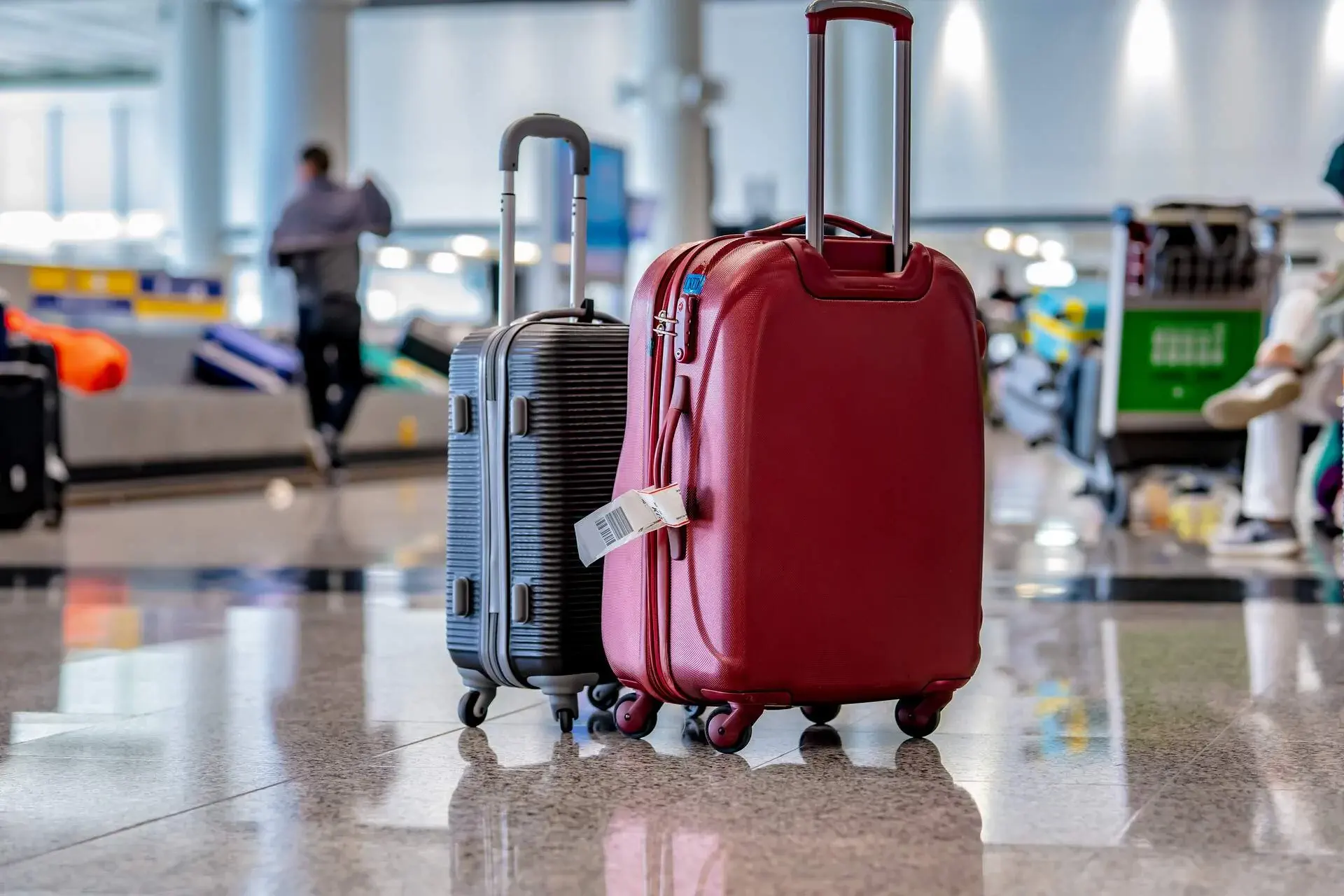
Your check-in luggage goes through so many things when you’re travelling. It gets handled in the airport, exposed to weather, or being dropped at carousels.
You don’t always have control over what happens next when your check-in bags are out of your hands at the check-in counter. That’s why you need to choose your check-in luggage carefully to get the best protection for your items.
Let’s explore these practical tips to protect your luggage from physical damage and other risks like sudden drops and improper handling.
1. Use Quality Luggage with the Right Locking Device
Durability is the top consideration when looking for the best check-in luggage in Australia. Durable luggage with a strong lock is your first line of defence.
A flimsy bag can be easily ripped, while compressed material forms like hard-sided cases can better protect your items.
- Choose a lock approved by the Transportation Security Administration (TSA) or a locking device that lets TSA agents open and re-lock your bag with a master key.
- Avoid non-approved locks that can be cut off at the screening points.
- Add zip ties as a tamper-proof option to prevent potential luggage theft.
Getting luggage locks provides you with peace of mind. Your personal items and important documents are well-protected.
2. Pack Smart and Protect Fragile Items
Unlike carry-on luggage, where you need to keep the breakables close, machines and baggage staff handle your checked luggage. Protect the fragile ones by:
- Using clothing to cushion souvenirs and items made of glass or porcelain.
- Placing medical items, human remains, and prescription medications in carry-on baggage.
- Not bringing tear gas, spray paint, or any other flammable materials.
Stains, shards, and foul smells will damage your checked bags if you fail to protect these items before you make your way back home.
3. Understand Powder and Aerosol Restrictions
Travellers leaving Australia through an Australian international terminal prior to boarding must follow strict rules. Some airports may restrict organic powders, inorganic powders, and aerosol containers.
Key guidelines include:
- Certain powders, such as foot powders, powdered detergent, talcum powder, and deodorant.
- Fine dry particles produced, such as sand- or talc-like textures, must be stored in a resealable plastic bag to prevent spills.
- Tip powders, like powdered deodorant, should be kept in all the containers with a fitted cap.
- Fish oil tablets may be allowed, but keep them away from aerosol containers.
- If any container is partially filled, make sure the bag’s sealed area is tightly closed. Spills on the luggage’s inner lining can be hard to clean.
Inbound flight restrictions can also vary for international terminal departures. Check with your airline before you board international flights.
4. Carry Essentials in Your Carry On
Store your medical items, visas, travel insurance, electronics, and prescription and non-prescription medicines for emergencies in your carry-on.
If you’re allowed to carry more than one bag, split the essentials between bags. For domestic flights, put your personal belongings in the carry-on and leave the bulkier ones in the checked luggage.
5. Avoid Overpacking and Stay Within Weight Limits
The airline may charge extra if your checked baggage exceeds the limit. That’s why you need to pack wisely. Here’s what will happen if you overpack:
- Compressed material can form shapes and stress the zippers.
- Solid substances, like heavy souvenirs, may puncture the baggage when it’s dropped.
- The inner lining of your baggage may get torn with rough handling.
Respecting weight restrictions and packing well can minimise stress on your luggage, making it last longer than expected.
6. Keep Food and Liquids Safe
Packing food to bring back home? These items need extra care to avoid spilling into the luggage.
Store your soft cheese in an airtight container. You can also wrap it in foil and store it in a resealable plastic bag. Freeze your gravy soups or replace them with a solid substance alternative.
Check the TSA’s guidelines on bringing food during flights to better prepare your items and decide what to bring home.
7. Collect Your Bag Quickly
The longer your bag stays on the baggage carousel, the more exposed it is to mishandling or theft. Once you arrive, stand near your assigned baggage carousel. When your bag slowly comes, get it right away and leave. You can attach brightly coloured straps to spot your baggage in a second.
8. Consider Travel Insurance
Accidents still happen despite all the precautions. However, airlines aren’t always liable for damage, so travel insurance covers damage to your personal belongings, lost bags, and theft.
Get travel insurance, especially if you’re travelling outside the country. Your baggage might pass multiple carriers before arriving.
Final Words
Protecting your checked luggage means a lot if you fly often. From using TSA-approved locks and tamper-proof devices to understanding restrictions, every step you take to protect your luggage ensures the longevity of your personal items. You’re also making your journey smooth and safe, whether you’re flying domestically or internationally.

 Blog8 months ago
Blog8 months agoHow to Deal with Scabies While Traveling

 Travel8 months ago
Travel8 months agoRichmond, Virginia Street Art Guide

 Travel8 months ago
Travel8 months agoPerhentian Islands: How to Get There, What to Expect, & More

 Travel8 months ago
Travel8 months agoHow to Live in Your Car in New Zealand

 Travel8 months ago
Travel8 months agoVegan Guide to Dining Out in Richmond, Virginia

 Travel8 months ago
Travel8 months agoSouvenir in Nepal: A Guide to Unique Handicrafts and Cultural Treasures

 Food8 months ago
Food8 months agoVegetarian Food Nepal: A Journey into Flavorful Plant-Based Cuisine

 Travel5 months ago
Travel5 months agoA Local’s Guide to Sanibel Island, Florida






